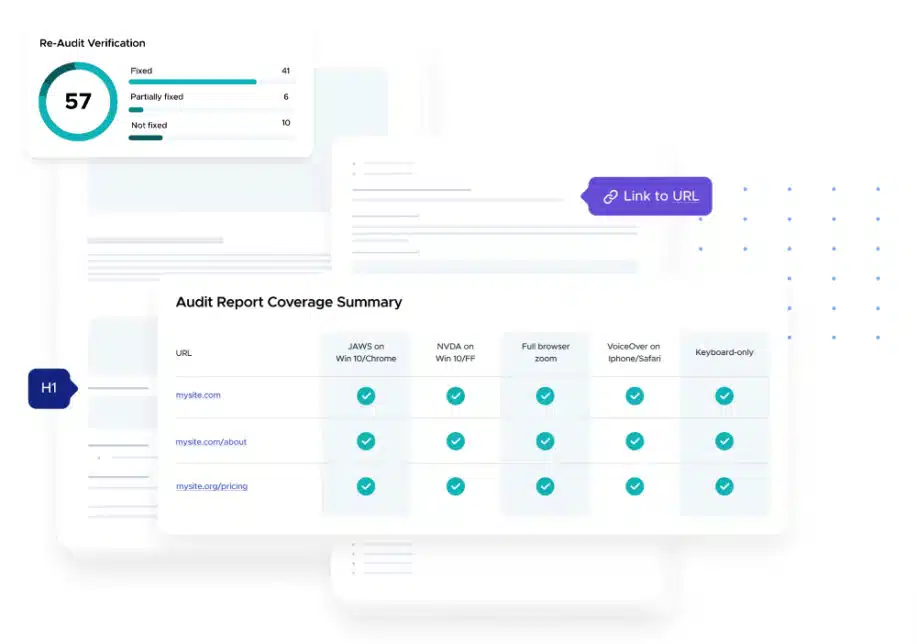As webmasters, we know how important it is to have a website that is both user-friendly and accessible to all users. That’s why an accessibility audit is a must for any website design team. This measure ensures that your website complies with accessibility regulations and standards and that it can be used by all users, regardless of their physical abilities.

Sponsored Message
A comprehensive accessibility audit also enables web admins to quickly and easily identify areas of their websites that aren’t compliant with accessibility standards. Moreover, a properly conducted audit covers various topics, including keyboard navigation, color contrast, and text alternatives. It also provides detailed recommendations on how to improve your website’s accessibility.
What is an Accessibility Audit?
An accessibility audit is a comprehensive evaluation of a digital product or service to determine if it meets the needs of people with disabilities. It can include technical, usability, and accessibility reviews.
The goal of an accessibility audit is to identify any potential barriers that could prevent people with disabilities from accessing and using the product or service.
Accessibility audits apply to websites, mobile apps, software programs, and other digital products. Third-party experts with vast experience in web accessibility and universal design principles typically spearhead these efforts.
Accessibility audits are a critical component of ensuring digital accessibility. They help organizations identify and address accessibility issues in their digital products and services. In this blog, we’ll discuss what an accessibility audit is and why it’s essential, as well as summarize the steps involved in conducting this type of audit.

Why is an Accessibility Audit Important?
An accessibility audit is crucial because it helps organizations identify and address potential barriers preventing users with disabilities from accessing and using their digital products and services.
This method makes it easier for everyone to use the product or service and ensures everyone has equal access to the digital space. In addition, an accessibility audit can help organizations avoid costly legal action or fines.
For example, in the United States, organizations must comply with the Americans with Disabilities Act (ADA). Under the ADA, organizations must provide access to their digital products and services for people with disabilities. An accessibility audit can help organizations ensure that their digital products and services meet the ADA’s requirements and avoid any potential legal action.
How to Conduct an Accessibility Audit
1. Establish Goals and Objectives
The first step is to establish the goals and objectives of the audit—this helps auditors determine the scope of the audit and what accessibility issues need attention.
2. Identify Relevant Accessibility Standards
The second step is to identify any relevant accessibility standards that the audit should address. This step could include the Web Content Accessibility Guidelines (WCAG) from the World Wide Web Consortium (W3C) or other standards specific to the product or service type.
3. Develop Test Plans
The third step is to develop test plans, including creating test cases to evaluate the product or service for accessibility.
4. Conduct Tests
The fourth step is to evaluate the product or service for accessibility—this may include automated tests, manual tests, and user testing.
5. Analyze the Results
The fifth step is to analyze the results of the tests to identify any potential accessibility issues.
6. Develop Recommendations
The sixth step is to develop recommendations for addressing any identified accessibility issues.
7. Create an Accessibility Statement
The seventh step is to create an accessibility statement. This document should include details on the product’s accessibility features and the actions that increased accessibility.
Legal Accessibility Requirements By Region
Depending on your location, non-compliance can lead to costly legal ramifications. Typically, punitive action varies based on the business model and financial profile, and public firms face the most rigid scrutiny. Below, we break down web accessibility guidelines for the United States, Canada, and the United Kingdom.
United States
The ADA (Americans with Disabilities Act) and Section 508 apply to U.S. compliance enforcement. The ADA protects people from disability-based discrimination. It applies to private and public sectors and concerns all aspects of daily life. Confusingly, the ADA’s written guidelines don’t address digital accessibility—but courts continually interpret that digital assets must comply with its mandates. Section 508 and Section 504 enforce digital accessibility for federal and federally-backed agencies.
Canada
Ontario-based organizations—nonprofits and privately held companies with 50+ staff members—must meet AODA (Accessibility for Ontarians with Disabilities Act) compliance standards. Different provinces have different required guidelines, but federal legislation is progressing. That’s why it is best to be proactive concerning website compliance to stay ahead of the legal curve.
EU – European Union
EN 301 549 enforces tech accessibility in the EU public sector and applies to all matters concerning websites (desktop and mobile), apps, and related devices. In addition, it aims to establish consistency regarding digital access locally and nationally—all global corporations that partner with EU firms must also satisfy EN 301 549 standards.
UK – United Kingdom
The Equality Act of 2010 is the compliance standard for U.K. organizations. It requires sensible modifications for making websites and communications accessible to people with disabilities. Public sector enterprises are most affected by the Act, but private sector organizations will likely soon face the same level of scrutiny with future legislation.
In all of these cases, not complying with accessibility legislation can have legal, financial, and brand implications and cause you to lose out on potential customers who cannot access or use your website. As a result, fixing these issues is vital before they become a significant problem for your organization.
Globally
Web Content Accessibility Guidelines (WCAG) 2 provides universal web accessibility guidelines. Its goal is to satisfy the needs of people, companies, and governments with consistent standards everyone can follow across the globe.
Digital Accessibility is Also Better for Business
Conducting a web accessibility audit is a crucial first step for accommodating all users and protecting your company legally. But it’s also an essential business strategy. Digital inclusivity opens your online sales to people with disabilities, the largest global minority group. Moreover, consumers increasingly choose brands that align with them ethically.
In short, committing to inclusion and digital accessibility will elevate your brand image and help boost your bottom line. That said, an accessibility audit will help your business attract and retain people with disabilities, a significantly underserved demographic.
Conclusion
Accessibility audits are an essential part of ensuring digital accessibility. They help organizations identify and address potential barriers preventing people with disabilities from accessing and using their digital products and services. By conducting an accessibility audit, organizations can ensure that everyone has equal access to their digital products and services and avoid costly legal action or fines.
An accessibility audit is also crucial to helping your online business reach more customers. After all, people with disabilities represent the most significant global minority. The more you connect with them online, the more you increase sales and brand loyalty. Above all else, digital accessibility is better for companies and better for society. So why not start your accessibility audit today?

